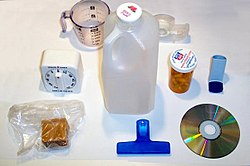 | |
| Identifiers | |
|---|---|
| Properties | |
| Appearance | colorless solid |
| Density | 1.13 g/cm3 |
Refractive index (nD) | 1.464 |
Except where otherwise noted, data are given for materials in their standard state (at 25 °C [77 °F], 100 kPa). | |
Poly(ethyl acrylate) (PEA) is a family of organic polymers with the formula (CH2CHCO2CH2CH3)n. It is a synthetic acrylate polymer derived from ethyl acrylate monomer. The polymers are colorless. This homopolymer is far less important than copolymers derived from ethyl acrylate and other monomers. It has a low glass-transition temperature between -8 °C [1] and -24 °C. [2]

